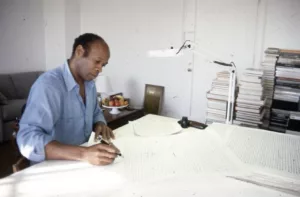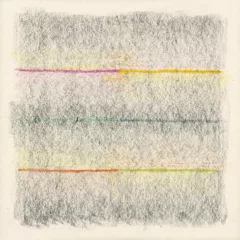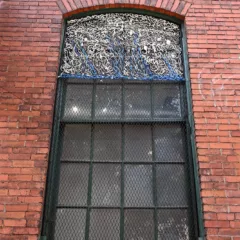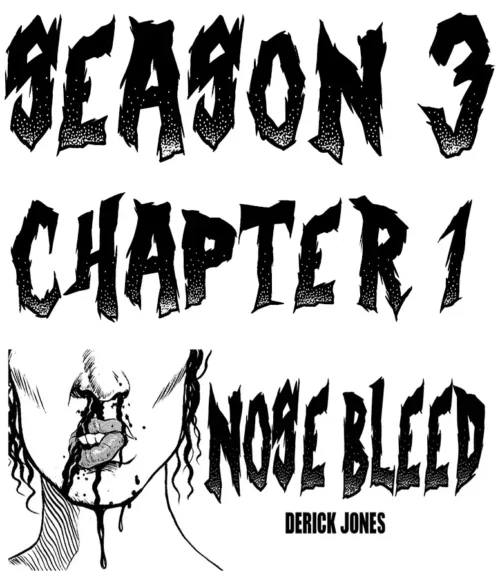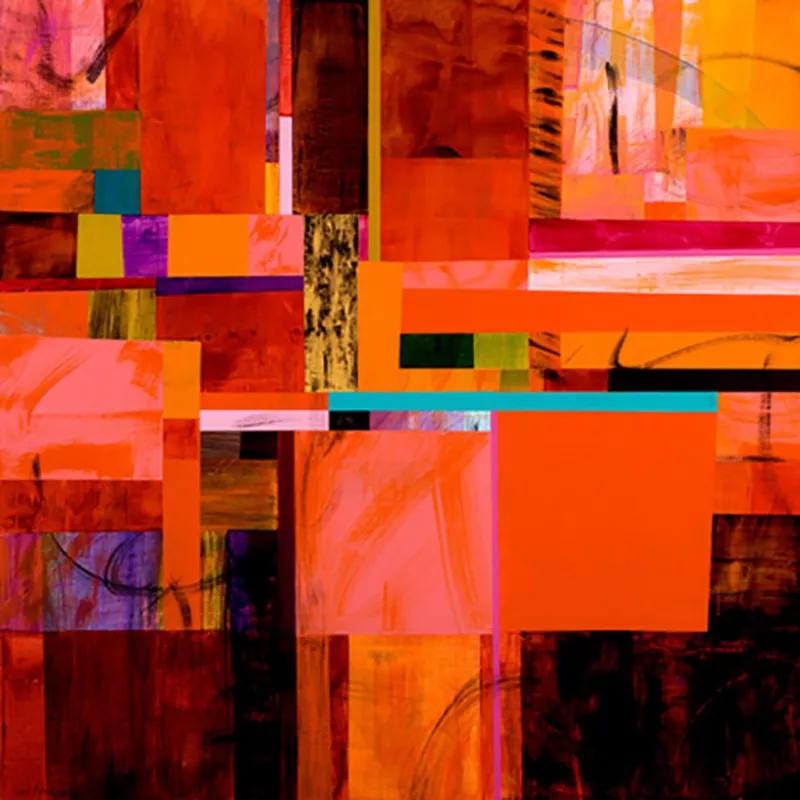
Val Rossman makes art that is joyful, playful and enigmatic. It’s also atmospheric – and abstract. Rossman paints variously in two distinct bodies of work, and draws on paper with pastels in a third body. Gestural mark-making throughout unifies the works as by one hand. In a recent conversation, I talked with Val about her various ways of working and what drives her vision. And I found an artist and art educator with a delightful positivity, humor, seriousness of purpose and level-headed common sense. Edging into a noisy and turbulent 2025, artists like Rossman – who look outward and inward and assert the importance of beauty, joy and quietude – are needed in our world.
The paintings and pastels
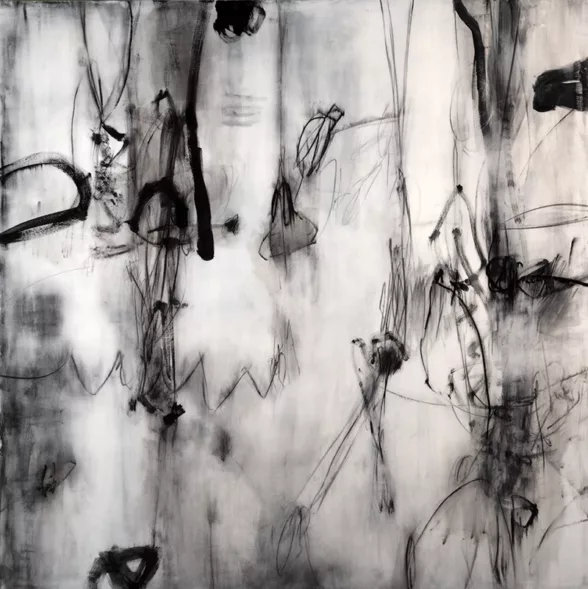
Rossman works flat on the wall in her North Philadelphia studio. She works on panels or metal and paper. In one group of paintings, geometry is a touchstone. Those colorful, ebullient works sprawl edge-to-edge like maps or blue prints. But unlike maps or blueprints, they have a dimensionality to them, a suggestion of deep and shallow space, with small and large color squares and rectangles facing off against each other in a push-pull playground.
In another painting group, color disappears, and contemplation and quietude step forward. The black-and-white paintings are dreamy, with a dense foggy scrim overall populated by ur-marks of black and gray swimming to the surface. Or perhaps they’re like what you see through a microscope with a blurry lens. The quiet atmosphere is rich and the mind wanders.
In her works on paper – the pastels – the artist is most playful and experimental. Some of the pieces have echoes of Miro’s bold cartoony floating worlds. Some of the works have great tactility, suggesting fabric quilts, others look like joyful colored versions of the black-and-white works. With their rich colors and creamy space, they sparkle and dazzle.
The Exhibit, Slow, Fast and In Between at SAMA
The artist works intuitively and has maintained a studio practice for 40-plus years, at the same time teaching (at Woodmere and Wayne Art Center among other places). She has an exhibit up right now at Southern Allegheny Museum of Art in Bedford, PA. The show, Slow, Fast and In Between, opened in November and is up until Feb. 2, 2025. It’s a big show – 40 works – in a mid-1800s historic house with fireplaces and crown moldings. “It was a challenge to hang work, because the walls are solid brick and they cannot put nails in the walls, and everything’s hung by strings from the soffits. So it’s not at all a traditional museum space,” she said.
The show came about through a network. A friend, Fred Danzinger, who collects art including Rossman’s, had a show of his collection at the SAMA museum. From that show Rossman and other artists were invited to contact the museum if they wanted to show their works. She reached out, and after a year of delays due to plumbing/HVAC issues in the historic house, her exhibition was mounted in 2024.
Rossman made new works for the exhibition plus borrowed some from galleries she has worked with (a Washington, D.C. gallery and Philadelphia’s Gross McCleaf). The works on view are all for sale.
“I wanted to show a combination (of works)…I really have two bodies of paintings, and they’re very different. One is geometric, very colorful, hard edge, but gestural at the same time. And the other is completely black-and-white and atmospheric and not geometric at all. It’s interesting to see them in conjunction with each other, because they play off of each other,” she said.
Color and Black and White
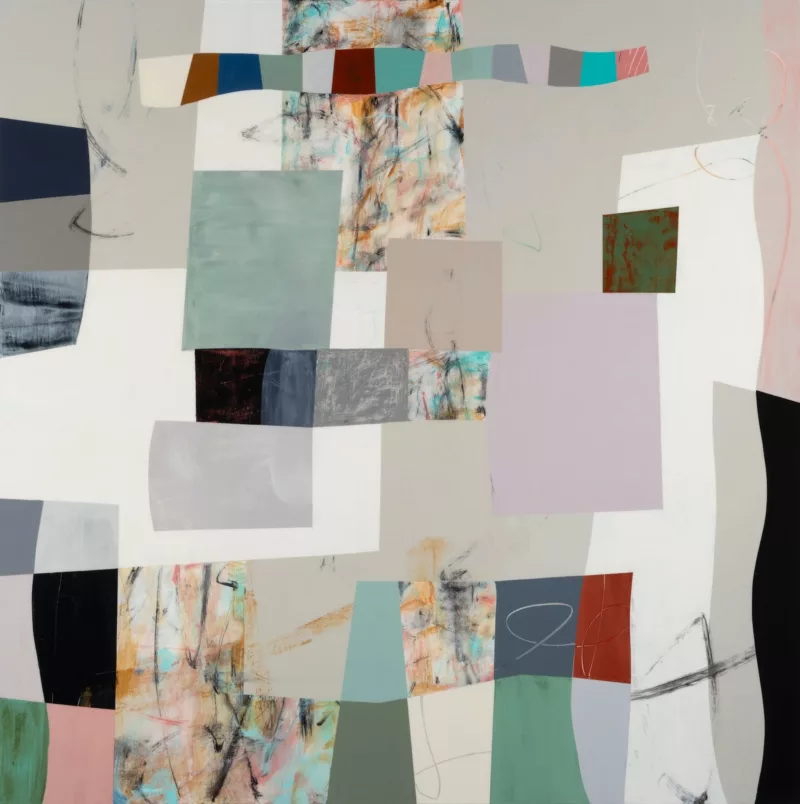
I was curious about her process. Did she work on the color paintings simultaneously with the black and whites? “I kind of go in a path, but it’s not completely separate. They’re both in my studio at the same time, but it’s not like “colors” in the morning, and “black-and-white” in the afternoon,” she explained.
Rossman is a beautiful colorist. Her color palette is bright and exuberant. And to work with black and white is like denying herself that exuberance. There is still exuberant mark making in the black-and-white’s but to deny herself color? Why, I wondered.
Turns out, it was a conscious effort to work in a different style and way in order to stave off use of any stale, over-used motifs. She doesn’t sketch things out ahead of time. But when, mid-painting, she sees patterns repeating and “happy accidents” repeating and the paintings starts to get predictable, she decided to try a new way, without color.
“I thought, well, just exactly because I’m a colorist, and I see the world first with color and in terms of color, and the way I record a situation is through color and movement. That is my first go-to. And I thought, what would happen if I denied that to myself? If I didn’t have my crutch to turn back to and eliminated all color, what would happen. So that was the main motivation. The other motivation was that I’m a runner and a walker. “
Running and Walking
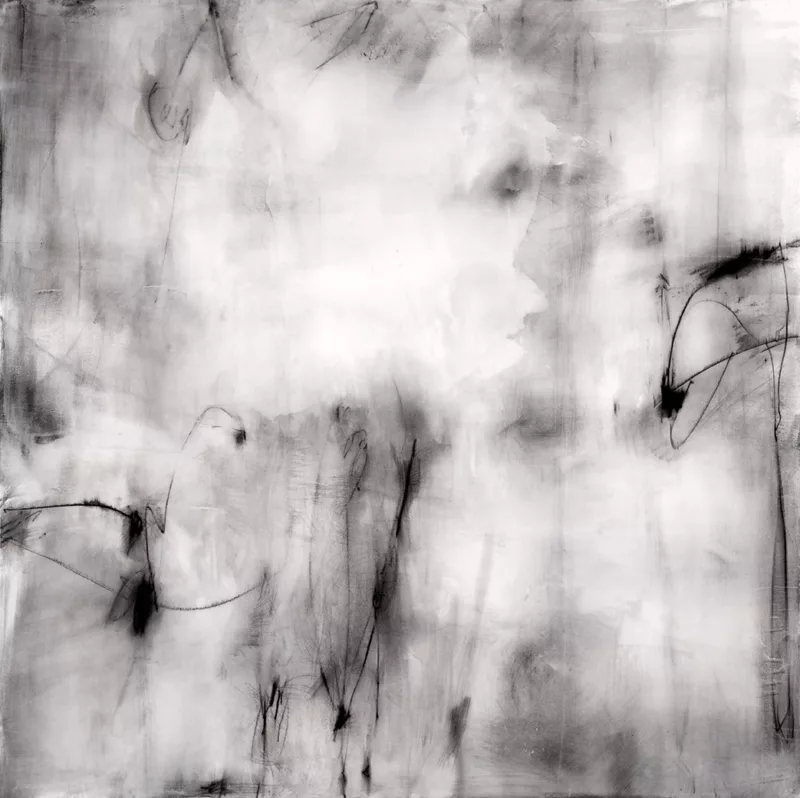
“I look down, oftentimes, (when I run). I don’t want to trip and fall, but I’m always seeing the shadows that are cast by the bushes and by the trees, and they’re very ethereal. And for years I’ve thought about how to capture that, because I’m abstract. How do I capture that without making the shadow of the tree? How do you catch that elusive feeling? Plus, not only do you see that elusive shadow, but you’ll see a branch that’s cutting across it.”
You’ve got to admire artists who mix it up. I was very interested that the switch to a series in black-and-white grew from frustration with her actual color practice (getting too easy, repeating herself) and from her immersion in the real world of walking and running and observing, looking down at shadows, and not sketching but imbibing the sensuality and mystery of nature, of life and distilling that in the studio. She described the process as detective work.
She tried doing this same type of atmospheric work with color added but said, “The color disturbed it; it was too jarring.”
Creating space and AI
Rossman’s method is to create layer upon layer upon layer. Things change in the process, with blocks being moved or covered over, colors enhanced or made quieter. Gestural marks made, moved and erased, and added again. It’s a lot of “editing” in real time going on in any one of her paintings. Because the finished works create deep space and shallow space I wanted to know if she ever played with AI and its magical ability to do …almost anything.
She thought about it. But no. And that led immediately to discussion of what is the metaphor for what she paints or makes.
The Underlying Metaphor
“I think the underlying metaphor, whether it’s for the black and whites or the geometrics or the pastels, is life in general. There’s the intersection between organization, planning our lives, figuring out a path forward, and then regardless of race, ethnicity, rich man, poor man, woman, child, doesn’t matter, things happen and disrupt our plan.”
“And then you have to reroute and figure out. So, that challenge between organization and interruption and chaos, and balancing that out has always been important to me…in my work. In addition to color, that idea of disruption, it’s just there.”
Titles
Rossman titles her works with words and phrases that make sense but make you question their relationship to what you are seeing. The titles seem very internalized. (“A Good Start” “Amid the Endless Tangle” “A Position of Strength.”) I wondered if the titles came at the end of the piece, end of the struggle, or did they happen along the way.
“I’m so glad you asked that. I have a really idiosyncratic way of titling my paintings. And I didn’t always do it this way, but I’ve been doing this way for a long time.
“I go through the newspaper, usually the New York Times, because that’s the main one that I read, and I find phrases that I like. And sometimes the phrase is the end of one sentence and the beginning of another…I have lists of phrases.
She does not title them until after the works have been photographed. It’s when she sees them in that meta-space that the “voila!” moment happens and she will find a phrase that matches the piece – kind of like in a game. “It’s sort of my personal comment that the world really doesn’t make sense, and this is my way of making sense of it. And it’s a lot of fun,” she confessed.
Taking the Birds Eye View
Sometimes, Rossman said, she imagines herself as a tiny speck in the space she has created. She wonders how she would move around in the space, or, as a tiny speck in the space could she move the shapes, lines, things around. I was charmed by this bit of artistic imagination. We’ve all imagined putting ourselves into a painted space, be it abstract or realist. But, that total immersion a creator gets into when they are in the process of making the work, that is a deep imaginative space.
Messiness
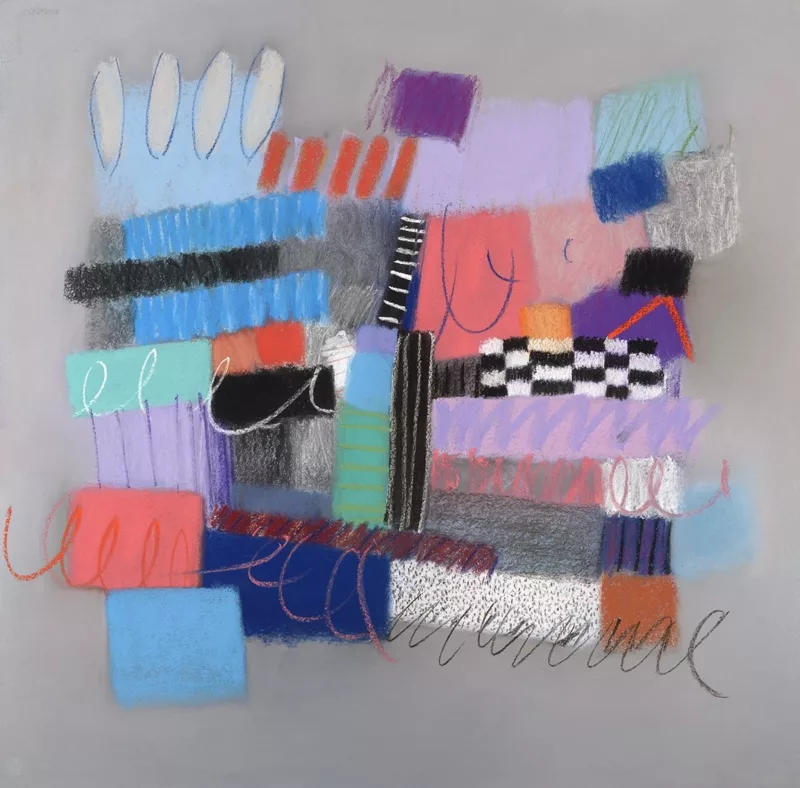
Rossman’s works have a pristine, finished quality. You know they have been made carefully, over time (long time in some cases) and they look “flash frozen,” like everything is in its right place. That is of course the artist’s magic. To make it look “right” effortlessly. But she works with paints and with pastels, surely the messiest material of all. So, does she get her fingers dirty? Her jeans and t-shirt? About pastels she said she loves them because they’re rich and direct and juicy and very sensual. But, “Yeah, everything gets messy, your body, your fingers, the floor. it’s a very messy medium.”
Remember that she works on the wall, including with the pastels, which produce a lot of dust that gravity will push right down on the floor. But, learning from trial and error and over time, the artist created a system for her pastels. She makes paper troughs, for the dust to fall into so it is contained and not stepped on and tracked all over the studio. It’s a gerryrigged system but it works.
She doesn’t wear a mask and I wondered about all those dust particles in the air. Covid has made us aware of them, if we weren’t before. Val reminded me that when using pastels they create dust on the paper surface as well as in the air and to get rid of the dust on the drawing itself what do you do? You blow on it, of course. And wearing a mask, it would be up and down, on and off as you worked and blew the excess away and worked some more. Rather frustrating, she said, adding that she tries not to do 6 continuous hours of pastels in the studio.
Quilting
Because the pastel works are very tactile, I asked Rossman about quilts or if she had ever worked in fabric, and she has not but loves quilts, especially Gees Bend quilts that are actually quite like abstract paintings when you see them on a wall. She said, “I like the concept of what a quilt is. They have history, and relationships, and they’re related to people and things and bringing that all together. So, although I’ve never personally quilted, I love the concept of it.”
Music
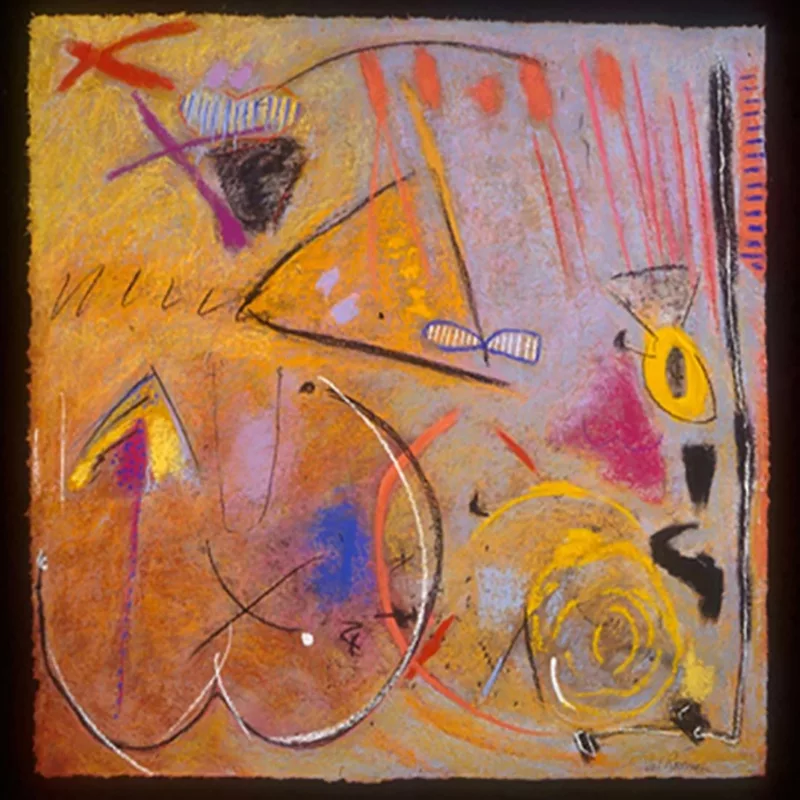
Many artists listen to music of some sort while working, and I’m alway interested in that. But especially for Rossman, whose works involve push-pull rhythms and areas that seem to crescendo or decrescendo, I wanted to know what music she listened to. The answer: Mozart, Schubert, some jazz but the more traditional kind, upbeat.
“Sometimes I put on upbeat dance type music, and I’ll dance around my studio just to kind of free myself up, to not take it so seriously, to open up. But music, I always, always listen to music. And even when I teach, I bring in a radio…I have to have music. No quiet. Quiet is not good.”
Also no NPR talk shows. Not in the studio, except when she’s doing administrivia that doesn’t require deep concentration, like packing up art for a big show or maybe a studio clean up day. “When I’m actually creating, talk is such a distraction,” she said.
The Troughs
For more than 40 years, Val Rossman has been productive, very productive. With solo shows, group shows, teaching, and more art making. She had hinted that there were ups and downs in her studio practice. Times of great production and then fallow times. I wanted to know more about that. She prefaced her answer talking about self-discipline and her no-nonsense, chicken on lettuce every day for lunch personality. Sounding very much like someone who says this to her students, she said, “You have to have discipline, because not every day is going to be a great day. You have to show up, and you have to do it. You don’t have the luxury to wait for whatever to strike you. You just have to plow along and keep going.”
She’s had down times when she got bored with the series she was working on or it seemed overdone. But she knows whatever happens she must show up and work. And sometimes the work takes the form of play. Lightening up about yourself and your work.
“That’s why I’ll dance around. You have to be willing to make a mess. You have to be willing to make stuff that’s not good. Make mistakes. And out of the dumps, something comes. And that’s that spark. You don’t know when it’s going to hit. It’s scary because as a creative person, that creativity…you can’t measure it. You can’t confine it or define it. You can’t study for it. It’s there. Or it’s not there. And I guess I keep telling myself, if I’m in the trough, ‘Look, I’ve been here before; I’ll come out of it. It is part of who I am.’
“So maybe it’ll take a month, maybe it’ll take four months, whatever it is. I’m going to come out of it. And I keep working.”
What should people see in your art
A question I often ask an artist is what do you want people to see or think when they look at your art? It’s not a loaded question. I’m just trying to get at the audience component of art and what an artist’s hopes are for that. Rossman’s answer told a story and wound up with the answer that she’s communicating joy and she hopes people receive that message.
“Creating art brings joy to me. And so I want other people to have that joy. I love when people buy my work. I love it. I mean, obviously I like the money but I love more than the money. I love that someone is willing to look at something that I’ve created every day, and it brings them joy.”
Playing with pastels, Covid, and Moe Brooker
I asked Rossman a question about the late Moe Brooker because some of her pastel works have a similar jazzy vibe to that of Brooker’s works. Her works are not influenced by his works, she said, but oddly enough, years ago the two of them were in the Spring Garden Street artist studios and his studio was across the hall from hers.
That pastel series we talked about started during Covid, when art supplies (and other supplies) were unavailable, and she couldn’t get wood panels to paint on, or paint, even, but she had lots of paper and lots of pastels. So she began a series of pastels. And it was her “playtime” with those materials – experimenting, unpredictable results, and she loved it. It was fun. And the series is about relationships, something we were deprived of during Covid lockdown.
A New Gallery
Speaking of relationships, Rossman told me she had joined Muse Gallery, the artist collective in Old City. She is excited and excited to be in an artist community. She had a piece in their December group show (closed Dec. 29), and will have her first solo exhibit there in 2026.
Joy and Community
What I see in Rossman’s work is a communication about humans and community. The compositions are rich and allusive. But their heartbeat is one of community. People pushing against each other, trying to speak, trying to communicate. Expressing the togetherness of crowds and multitudes. There’s joy in them and that is a major thing, because we need more joy in the world.
Visit the artist’s website for more information and images.
Slow, Fast and In Between, Southern Allegheny Museum of Art, Bedford, PA, until Feb. 2, 2025.
Want more Artblog? Read the 2024 Liberta Awards!


